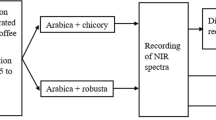Abstract
Coffee is one of the main exported products of Colombia. It is grown in different regions throughout the territory and is recognized worldwide for its flavor and freshness. Its quality is evaluated by professional tasters, who taste the coffee drink obtained from roasted coffee beans. They qualify it according with the platform or method requested by customers. This study proposes the use of different Machine Learning (ML) algorithms for the prediction of cup coffee quality, based on a set of measurements made to almond and roasted coffee beans. The data was obtained with the support of Almacafé, a company belonging to the National Federation of Coffee Growers (FNC) of Colombia. The classification results with the validation set, showed a higher accuracy with the Neural Network algorithm, with an average score of 81% for a 10-fold stratified cross validation. This work demonstrates the possibility of qualifying cup coffee quality with ML algorithms.
Access this chapter
Tax calculation will be finalised at checkout
Purchases are for personal use only
Similar content being viewed by others
References
Thomas, E., Puget, S., Valentin, D., Songer, P.: Sensory Evaluation-Profiling and Preferences. Elsevier Inc., London (2017)
Salamanca, C.: Métodos Estadísticos Para Evaluar La Calidad Del Café. Universitat de Girona (2015)
de Oliveira, E.M., Leme, D.S., Barbosa, B.H.G., Rodarte, M.P.: A computer vision system for coffee beans classification based on computational intelligence techniques. J. Food Eng. 171, 22–27 (2015). https://doi.org/10.1016/j.jfoodeng.2015.10.009
Faridah, F., Parikesit, G.O.F., Ferdiansjah, F.: Coffee bean grade determination based on image parameter. TELKOMNIKA (Telecommun. Comput. Electron. Control) 9, 547–554 (2011). https://doi.org/10.12928/telkomnika.v9i3.747
Montes, N.: Segmentación De Imágenes De Frutos De Café En El Proceso De Beneficio. Universidad Nacional de Colombia, sede Manizales (2003)
Ruge, I.A., Pinzon, A.S., Moreno, D.E.: Sistema de selección electrónico de café excelso basado en el color mediante procesamiento de imágenes. Rev Tecnura 16, 84–93 (2012). http://dx.doi.org/10.14483/udistrital.jour.tecnura.2012.4.a06
Ramos Giraldo, P.J., Sanz Uribe, J.R., Oliveros Tascón, C.E.: Identificación y clasificación de frutos de café en tiempo real, a través de la medición de color. Cenicafé 61, 315–326 (2010)
Carvajal, J.J., Aristizábal, I.D., Oliveros, C.E., Mejía, J.W.: Colorimetría del Fruto de Café (Coffea arabica L.) Durante su Desarrollo y Maduración. Rev Fac Nac Agron Medellín 1, 37–48 (2006)
Tobijaszewska, B., Mills, R., Jons, J.: El uso de la espectrometría para la medición simultánea del color y la composición en muestras de alimentos. In: FOSS (2018). https://www.fossanalytics.com/-/media/files/documents/papers/meat-segment/using-spectrometry-for-simultaneous-measurement_es.pdf
Cortes, C., Vapnik, V.: Support-vector networks. In: Saitta, L. (ed.) Machine Learning, pp. 273–297. KlugerAcademic Publishers, Boston (1995)
Nascimento, R.F.F., Alcântara, E.H., Kampel, M., et al.: O algoritmo SVM: avaliação da separação ótima de classes em imagens CCD-CBERS-2. XIV Simpósio Bras Sensoriamento Remoto 2079–2086 (2009)
Gala, Y.: Algoritmos SVM para problemas sobre big data. Universidad Autonoma de Madrid (2013)
Chang, C.C., Lin, C.J.: LIBSVM: a library for support vector machines. ACM Trans. Intell. Syst. Technol. 2 (2011). https://doi.org/10.1145/1961189.1961199
Shalev-Shwartz, S., Ben-David, S.: Understanding Machine Learning: From Theory to Algorithms. Cambridge University Press, New York (2014)
Gallo, C.: Artificial Neural Networks: tutorial (2015)
Hornik, K., Stinchcombe, M., White, H.: Multilayer feedforward networks are universal approximators. Neural Netw. (1989). https://doi.org/10.1016/0893-6080(89)90020-8
Chollet, F.: Keras (2015) (2017). http://keras.io/
Pedregosa, F., Varoquaux, G., Gramfort, A., et al.: Scikit-learn: machine learning in Python. J. Mach. Learn. Res. 12, 2825–2830 (2011)
Forman, G., Forman, G., Scholz, M., Scholz, M.: Apples-to-apples in cross-validation studies: pitfalls in classifier performance measurement. HP Labs 12, 49–57 (2009). https://doi.org/10.1145/1882471.1882479
Zhang, Y.D., Yang, Z.J., Lu, H.M., et al.: Facial emotion recognition based on biorthogonal wavelet entropy, fuzzy support vector machine, and stratified cross validation. IEEE Access 4, 8375–8385 (2016). https://doi.org/10.1109/ACCESS.2016.2628407
Kotsiantis, S.B., Kanellopoulos, D.: Data preprocessing for supervised leaning. Int. J. Comput. Sci. 1, 1–7 (2006). https://doi.org/10.1080/02331931003692557
Ferreira, E.J., Pereira, R.C.T., Delbem, A.C.B., et al.: Random subspace method for analysing coffee with electronic tongue. Electron. Lett. (2017) https://doi.org/10.1049/el:20071182
Dunne, R., Campbell, N.: On the pairing of the Softmax activation and cross-entropy penalty functions and the derivation of the Softmax activation function. In: Proceedings of 8th Australian Conference Neural Networks (1997). https://doi.org/10.1.1.49.6403
Agarap, A.F.: Deep learning using rectified linear units (ReLU), pp. 2–8 (2018)
He, K., Zhang, X., Ren, S., Sun, J.: Delving deep into rectifiers: surpassing human-level performance on imagenet classification. In: Proceedings of IEEE International Conference Computer Vision 2015, pp. 1026–1034 (2015). https://doi.org/10.1109/ICCV.2015.123
Kingma, D.P., Ba, J.: Adam: a method for stochastic optimization, pp. 1–15 (2014)
Acknowledgement
Special thanks are given to the Office of coffee quality Almacafé, for its interest in this work and for providing samples, measuring input attributes and cupping them.
Author information
Authors and Affiliations
Corresponding author
Editor information
Editors and Affiliations
Appendix A
Appendix A
Link to the notebook used in Colab and the corresponding database:
https://github.com/Javiersuing/GitHub/blob/master/AlmacafeDataBase_CrossV_v4.ipynb.
Rights and permissions
Copyright information
© 2020 Springer Nature Switzerland AG
About this paper
Cite this paper
Suarez-Peña, J.A., Lobaton-García, H.F., Rodríguez-Molano, J.I., Rodriguez-Vazquez, W.C. (2020). Machine Learning for Cup Coffee Quality Prediction from Green and Roasted Coffee Beans Features. In: Figueroa-García, J.C., Garay-Rairán, F.S., Hernández-Pérez, G.J., Díaz-Gutierrez, Y. (eds) Applied Computer Sciences in Engineering. WEA 2020. Communications in Computer and Information Science, vol 1274. Springer, Cham. https://doi.org/10.1007/978-3-030-61834-6_5
Download citation
DOI: https://doi.org/10.1007/978-3-030-61834-6_5
Published:
Publisher Name: Springer, Cham
Print ISBN: 978-3-030-61833-9
Online ISBN: 978-3-030-61834-6
eBook Packages: Computer ScienceComputer Science (R0)




